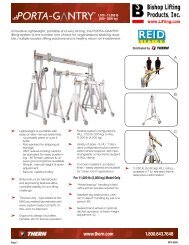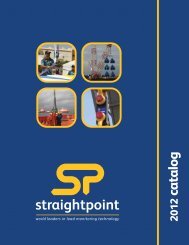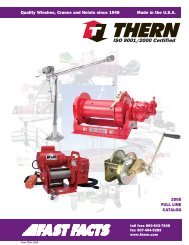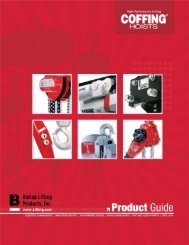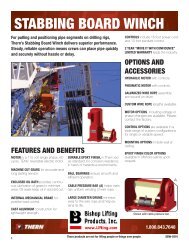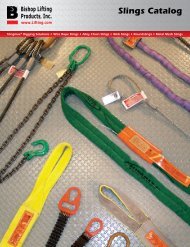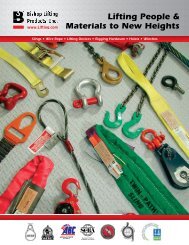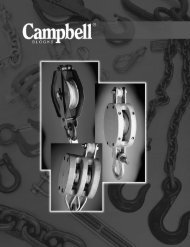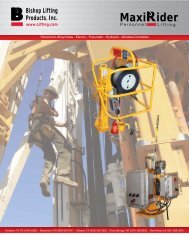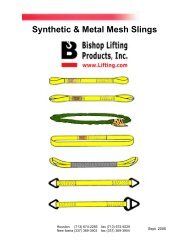warning - Bishop Lifting Products, Inc.
warning - Bishop Lifting Products, Inc.
warning - Bishop Lifting Products, Inc.
You also want an ePaper? Increase the reach of your titles
YUMPU automatically turns print PDFs into web optimized ePapers that Google loves.
Web Slings<br />
Identification, Inspection, Rigging Practices<br />
Rigging Practices<br />
• Slings shall be shortened or adjusted only by methods approved by the sling manufacturer or a qualified person<br />
• Slings shall not be shortened or lengthened by knotting or twisting<br />
• The sling shall be hitched in a manner providing control of the load<br />
• Slings in contact with edges, corners, or protrusions should be protected .with a material of sufficient strength, thickness, and<br />
construction to prevent damage to the sling<br />
• Shock loading should be avoided<br />
• Loads should not be rested on the sling<br />
• Slings should not be pulled from under the load when the load is resting in the sling<br />
• Twisting shall be avoided<br />
• During lifting, with or without load, personnel shall be alert for possible snagging<br />
• When using multiple basket or choker hitches, the load should be rigged to prevent the sling from slipping or sliding along<br />
the load<br />
• When using a basket hitch, the legs of the sling should contain or support the load from the sides, above the center of gravity,<br />
so that the load remains under control<br />
• Slings should not be dragged on the floor or over an abrasive surface<br />
• In a choker hitch, the choke point should only be on the sling body, not on a splice or fitting<br />
• Slings should not be constricted, bunched or pinched by the load, hook, or any fitting<br />
• The load applied to the hook should be centered in the base (bowl) of the hook to prevent point loading on the hook, unless<br />
the hook is designed for point loading<br />
• An object in the eye of a sling should not be wider than one half the length of the eye<br />
Environmental Considerations<br />
• Temperature<br />
o Polyester and nylon webbing slings shall not be used in contact with an object or at temperatures in excess of 194°F (90°C)<br />
or below (-40°C)<br />
• Chemically Active Environments<br />
o The strength of synthetic web slings can be degraded by chemically active environments. This includes exposure to chemicals<br />
in the form of solids, liquids, gases, vapors, or fumes. The sling manufacturer or qualified person should be consulted before<br />
slings are used in chemically active environments<br />
• Sunlight and Ultraviolet Light<br />
o The strength of synthetic webbing slings is degraded by exposure to sunlight and ultraviolet light. The sling manufacturer<br />
or qualified person should be consulted for additional retirement or inspection requirements. For additional information,<br />
see WSTDA-UV-Sling-2003<br />
Sources:<br />
ASME B30.9 "Slings" Standard<br />
WSTDA "Web Sling and Tie-Down Association<br />
OSHA 1910.184 "Slings"<br />
OSHA 1926.251 "Rigging Equipment for material handling"<br />
WEB SLINGS<br />
(800) 972-1041 Web Slings 113



